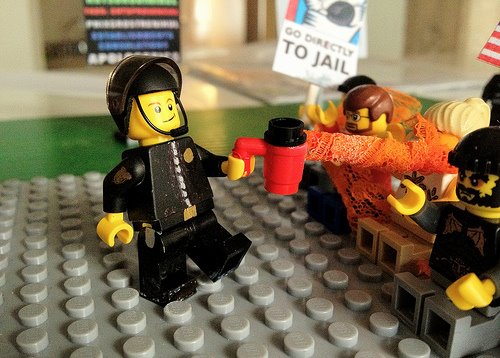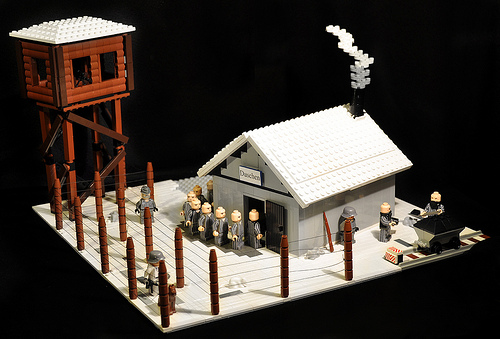A funny spoof on Lego sets and toy commercials is circulating on YouTube, but humorous in a somewhat disconcerting way. Almost a decade ago, Donald Kuspit made a famous assertion on a Rudolf Herz piece of art showing photos of Hitler and Marcel Duchamp. Kuspit affirmed it was completely coherent and Duchamp was a terrorist as well. His ready-made meant that anything can be art meaning in the current case of Lego, that yes, a concentration camp can be built from Lego and Lego can depict police state scenarios…. But the video is not that far off from the actual sets since Lego has been producing a series of cops and robbers themes lately that are disturbing and recall that corrupted romanticism of pop culture and its kitschy undertones are a fecund context for Lego to explore. Oh yes, the robbers do appear to resemble hillbillies….

Lt. John Pike. read More:http://motleynews.net/2011/11/26/okay-one-last-post-of-pepper-spray-cop-lt-john-pike-meme-art/
Imagine my surprise, then, when, while looking for holiday presents and blithely scrolling through the Lego offerings on the site, I came across a set for the 5- to 12-year-old Lego aficionado called — are you ready? — a Prisoner Transport vehicle. It has high user ratings and comes with a prisoner, a policeman and, well, a prisoner-transport vehicle with gated windows. I almost had a coronary. Is Lego normalizing the prison industrial complex to 5-year-olds?…

Read More: http://thesocietypages.org/sociologylens/2011/01/18/identifying-play-as-normalizing-practice-connecting-legos-prison-transport-vehicle-to-the-prison-industrial-complex/ --- Walker points out that one of the Lego Group’s toys, the “Prison Transport Vehicle,” presents incarceration as “play,” which is similar to her, and other’s, conceptualization of the way that African Americans are treated in the criminal justice system vis-à-vis the disciplinary power elite. She writes, “But at a time when more African Americans are in the criminal justice system than were enslaved in 1850, the mass incarceration of one – arguably targeted – group is a lot like war, and thus the Prisoner Transport Vehicle most definitely qualifies as making ‘war seem like child’s play’. Or, in this momma’s speak: indoctrinating kids into a for-profit system that often denies citizens adequate legal representation; strips them of basic human rights; criminalizes them for a lifetime; and rarely offers hope of rehabilitation or opportunity for personal, psychological growth.” Later in the article, Walker calls for “a little more scrutiny” over the Prisoner Transport Vehicle as well as other toys that “normalize incarceration.” So what aspects of incarceration is this toy normalizing? Drawing on Foucault’s reading that the process of normalization creates an effortless dichotomization of “normal” and “abnormal,” it appears that this toy has the potential to make getting transported to jail “normal,” getting handcuffed and arrested “normal,” etc.---
…I kept scrolling. Surely there was a tribunal set in which the guards who have been caught raping and abusing juvenile prisoners are held accountable for their actions. And what about a prisoner-DNA set, where our 6-year-old scientist pretends to discover that the prisoner doing the time didn’t actually do the crime? How about the set designed after the peaceful prison strike in December in Georgia, where thousands of inmates — black, white, Mexican and other — put aside their gangbanging to make a statement about the human potential for greater good? Read More:http://www.npr.org/2011/01/04/132646227/the-root-lego-makes-prison-seem-like-childs-play a

Read More:http://www.brothers-brick.com/2010/11/20/nazi-death-camp-in-lego/ ---A line of prisoners walks in the snow toward a building labeled “Showers” while other prisoners are forced to unload coal for the gas chamber’s engines. A guard leans his rifle against the wall of the building. The barrel of a sniper rifle pokes from the window of a watchtower overlooking the scene.---
ADDENDUM:
ZBIGNIEW LIBERA: Naturally, Lego was such an important piece that it divides my career into two parts. Lego brought me international recognition, and in this sense it really changed something. It is also very hard for an artist to have one of his works raise expectations very high. It becomes very hard to do any work after it. Sometimes such expectations even paralyze you, because you want to do something similar, but you cannot. And then you have to deal with the likelihood that you will never do something that significant again. It is a personal problem as well. But looking back over the years, it is not so simple to draw a dividing line. When I was working on the Lego project in 1996 it was not really known; it became well-known only a year later. But then, mentally I was at a somewhat different stage, I was dealing with different things. So where is this divide? Is it when I made “Lego” or is it when it became well-known, when I achieved recognition for it, which of course also changed me and my thinking about that piece?

Read More:http://users.erols.com/kennrice/lego-kz.htm ---As the founding chairman of the International Network of Children of Holocaust Survivors, Rosensaft asks: What can a Lego concentration camp mean, except that killing is child's play? What can one say about the Coke can picture except that it is a vulgar fabrication? Exhibiting them will be "a boon to skinheads," he says, because they "trivialize and demean the Holocaust and the sufferings of its victims." … Other works in the exhibit aim to put the viewer in the position of the victimizers rather than the victims. The "Lego Concentration Camp Set" by the Polish artist Zbigniew Libera, Berenbaum argues, "may be saying that the same type of creative construction that little boys do with Lego also took place at concentration camps." The point is that the camps did not just spring up. German companies submitted competitive bids, hired engineers and obtained zoning permits to build them. "I'm not sure I like it, but it sure raises an interesting question," Berenbaum says. "How much ingenuity, how much real thought, did it take to build the camps?" His broader point is that the works in "Mirroring Evil" may be difficult, provocative and open to interpretation, but each does have something serious to say. ---
H.T.:: Did Lego change your recognition in Poland or mainly abroad?








 COMMENTS
COMMENTS



